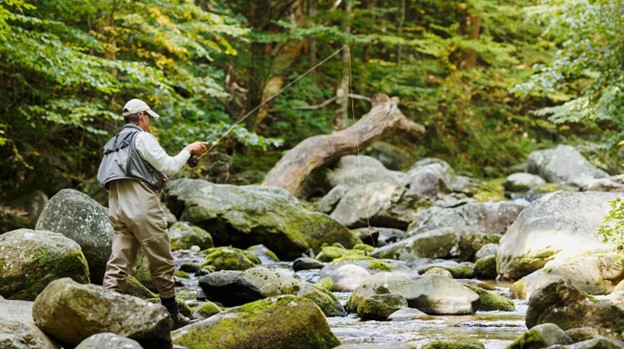By Nat Gillespie, Assistant National Fish Program Leader, USDA Forest Service
The following blog was authored by Nat Gillespie, Assistant National Fish Program Leader for the USDA Forest Service.
The U.S. Department of Agriculture’s Forest Service public lands offer some of the best recreational fishing destinations in the United States. With over 220,000 miles of fishable rivers and streams, over 10 million acres of lakes, reservoirs and ponds across 194 million acres, these public lands offer an array of fishing opportunities for the American public. More than 75% of the nation’s trout and salmon habitat are located on national forests, which also offer quality opportunities for trophy warmwater fishing.
National forests and grasslands are considered by many to be America’s recreational playgrounds, as they are all open to the public with appropriate state fishing licenses. Visitor use data demonstrates that recreational fishing across the country’s vast system of national forests and grasslands is big business in terms of the growing recreational economy. In 2022, these public lands hosted 8.3 million visits for recreational fishing, leading to 6,760 full-time equivalent jobs. Recreational fishing contributed $1.2 billion in economic output to local communities and contributed $664 million to the country’s GDP. The 154 national forests and grasslands located in 41 states and territories have extensive road and trail systems, boat infrastructure, and provide unparalleled public access, with many sites offering ADA accommodations. Though much harder to quantify, many people rely on fishing in national forests as a food source and nutrition, and to exercise deeply important cultural traditions.
Over the past several years Congress has designated federal funding through the Great American Outdoors Act, the Bipartisan Infrastructure Law, and the Inflation Reduction Act, to address deferred maintenance, infrastructure and improve fisheries habitat. The Forest Service has taken advantage of this funding, investing $635 million in over 1,000 projects to repair or rebuild recreation facilities, trails, campgrounds, roads, bridges, and boat access. In the past three years, the Forest Service has invested in dozens of projects that repair and rebuild fishing piers, boat docks, boat launches, and repairing dams at popular reservoirs. These investments improve visitor experience and access, as well as benefit fish populations and recreational fishing. This enables more visitors to fish within their national forests.
A recent investment is on Tennessee’s Cherokee National Forest. This project will construct a new boat launch at Sink Mountain Boat Launch, the only public access site to Watauga Lake, a popular 6,400-acre reservoir renowned for its diverse mix of angler favorite fish species.
Over the past two years the Forest Service has replaced over 200 fish passage barriers at road and trail culverts. Removing barriers benefit fish populations by reconnecting aquatic habitat, allowing fish to find important habitats for spawning or find places to survive droughts and floods. This type of infrastructure investment also creates a more flood-resilient transportation infrastructure to protect public access for local communities, as well as recreation. The Collaborative Aquatic Landscape Restoration Program focuses on improving fish passage and water quality on and off national forests by working with partners. The Forest Service provided $45 million for dam removals, culvert replacement, abandoned mineland restoration and stream restoration projects across the country. These projects improve fish habitat and benefit local recreational fisheries.
Another critical investment is in watershed restoration work like stream and wetland restoration, abandoned mineland reclamation and reducing the risk of damaging wildfires. These types of watershed restoration restore watershed health, fish habitat, and improve their climate resiliency, all of which will improve water quality and benefit recreational fishing. These federal funding streams enable the Forest Service to greatly expand its work with many important conservation allies, State fish and wildlife agencies and Native American Tribes. With our partners, the bottom line is when BIL and IRA funding sunsets in 2025, we will have replaced hundreds of fish passage barriers, improved thousands of miles of stream and river habitat, and improved tens of thousands of acres of important watersheds.
To be sure, the Forest Service doesn’t operate in a vacuum, and there are many other federal lands adjacent to our national forests and grasslands, and many other federal programs have received funding specifically for fish passage and the benefit of fish populations. The Federal Fish Passage Task Force – a newly formed effort including 11 federal agencies – are combining funds to invest billions of dollars to improve fish passage. Our coordination to prioritize and fund “transformational fish passage” projects will greatly increase recreational fish habitat across entire watersheds and larger stream, river and lake systems. The Federal Fish Passage Task Force portal maps show the fish passage projects across the country and we look forward to providing more updates in the coming months!
Share This Article, Choose Your Platform:
Recent Posts



